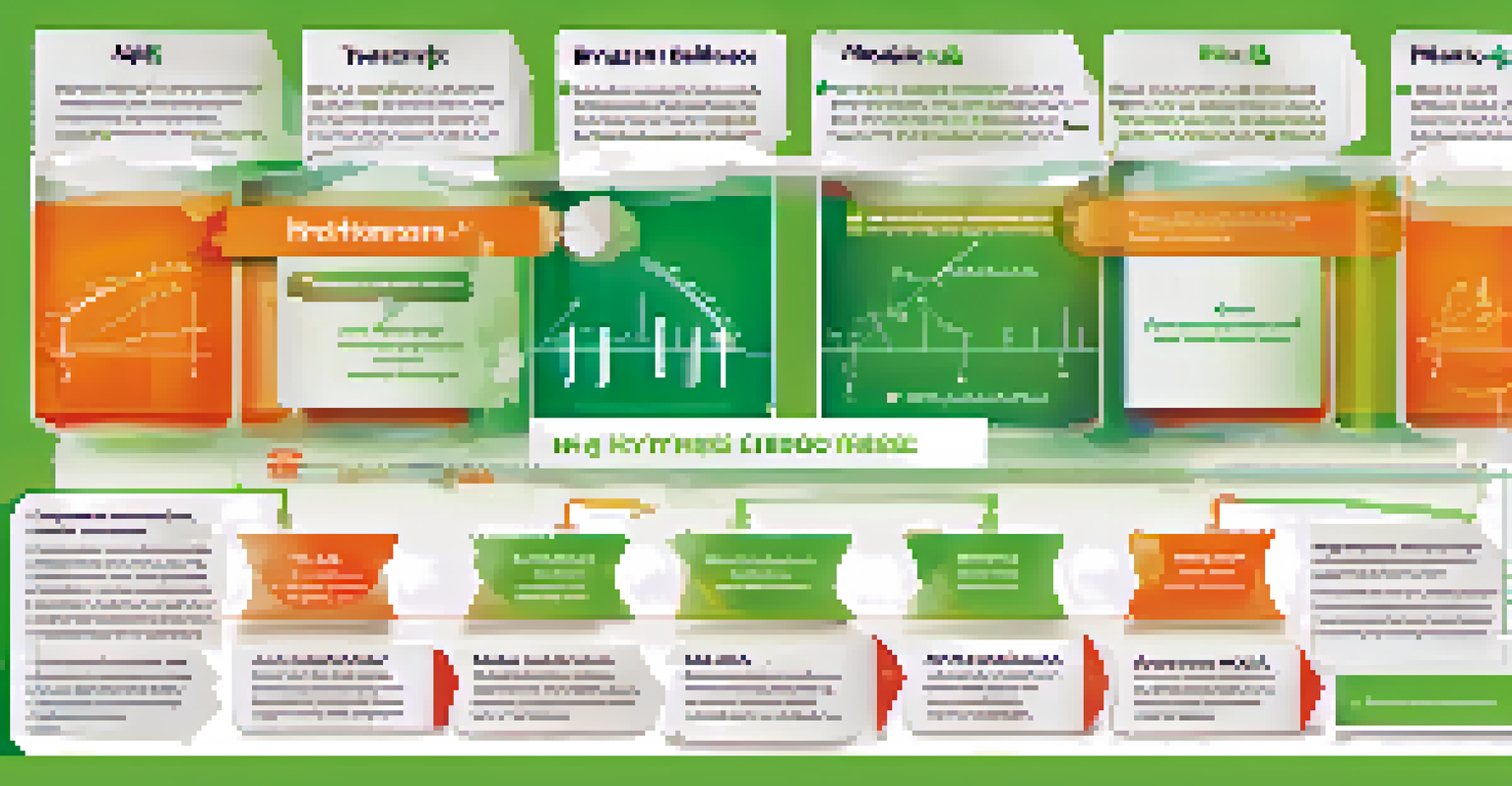Inferential Statistics: Making Predictions in Medical Research

Understanding Inferential Statistics in Medicine
Inferential statistics is a branch of statistics that allows researchers to make predictions or inferences about a population based on a sample. In medical research, this is crucial as it helps scientists draw conclusions about health outcomes without needing to study every individual in a population. By analyzing the data from a smaller group, researchers can estimate trends and effects that are likely to be present in the larger community.
Statistics are like bikinis. What they reveal is suggestive, but what they conceal is vital.
For example, if a study analyzes the effects of a new drug on a sample of patients, inferential statistics can help predict how the drug might perform in the broader population. This not only saves time and resources but also accelerates the development of effective treatments. It's like tasting a small piece of cake to judge the flavor of the whole cake—you get a good idea without needing to eat it all.
However, it's important to note that these predictions come with a level of uncertainty. Researchers must carefully consider factors such as sample size and variability to ensure that their conclusions are valid and reliable. This balance between precision and uncertainty is a hallmark of inferential statistics in medical research.
The Role of Hypothesis Testing in Predictions
Hypothesis testing is a fundamental aspect of inferential statistics that helps researchers determine the validity of their predictions. In medical studies, scientists often start with a null hypothesis, which suggests there is no effect or difference, and an alternative hypothesis, indicating there is an effect or difference. Through statistical tests, they can evaluate whether the observed data supports rejecting the null hypothesis in favor of the alternative.

For instance, in a clinical trial comparing a new treatment to a placebo, researchers would formulate hypotheses regarding the efficacy of the treatment. By analyzing the results, they assess the likelihood that any observed improvements were due to the treatment itself rather than random chance. This process is akin to a detective gathering clues to solve a case—the more evidence they gather, the clearer the conclusion becomes.
Inferential Statistics in Medicine
Inferential statistics allows researchers to make predictions about a population based on a sample, which is crucial for medical research.
Ultimately, hypothesis testing allows researchers to make informed decisions about the effectiveness of medical interventions. A strong result can lead to further studies, while weak results may prompt researchers to reconsider their approach. Thus, hypothesis testing is a cornerstone of making reliable predictions in medical research.
Confidence Intervals: A Measure of Certainty
Confidence intervals provide a range of values that likely contain the true population parameter, offering a measure of certainty around predictions. In medical research, this means that instead of just giving a point estimate, researchers can convey how much uncertainty exists around that estimate. For example, a study might find that a new drug reduces symptoms in patients by an average of 10 units, with a 95% confidence interval of 7 to 13 units.
In statistics, the great danger is not the use of a bad method, but the use of a good method in a bad way.
This range indicates that researchers are 95% confident that the actual reduction in symptoms lies between 7 and 13 units. It’s a powerful way to communicate the reliability of the results, as it helps clinicians understand the potential variability in treatment effects. Think of it like casting a fishing net—while you can catch some fish, the net size gives you an idea of how many you might expect to find.
However, it’s crucial to remember that confidence intervals do not guarantee that the true value falls within the specified range. They are based on the sample data and the assumptions made during the analysis. Thus, understanding confidence intervals is key to interpreting the results of medical studies accurately.
The Importance of Sample Size in Medical Predictions
Sample size plays a critical role in the reliability of inferential statistics. A larger sample size generally leads to more accurate estimates and narrower confidence intervals, thereby enhancing the credibility of research findings. In medical studies, choosing the right sample size is essential to ensure that the results are representative of the population being studied.
For example, a study with only a handful of participants may yield results that are skewed or not applicable to the broader population, much like a small focus group might not accurately reflect the opinions of an entire community. Researchers often conduct power analyses before a study to determine the optimal sample size needed to detect a meaningful effect, should one exist.
Importance of Sample Size
A larger sample size enhances the reliability of research findings, while a poorly chosen sample can lead to inaccurate conclusions.
Conversely, a study with a sample that’s too large can waste resources and may not provide significantly more information. Therefore, finding the sweet spot for sample size is a balancing act that can greatly influence the outcomes of medical research and the predictions made from it.
Bias and Its Impact on Inferential Statistics
Bias can significantly affect the outcomes of inferential statistics, leading to incorrect predictions in medical research. Bias occurs when certain factors systematically influence the results, making them unrepresentative of the true population. Examples include selection bias, where the sample is not randomly selected, or measurement bias, where data collection methods skew results.
For instance, if a study on a new treatment only includes participants who are already healthy, the findings may not be applicable to the broader population, including those with more severe conditions. This is akin to predicting the performance of a soccer team based solely on their practice sessions without considering their performance in actual games.
Researchers strive to minimize bias by using random sampling methods and standardized measurement techniques. Awareness of potential biases allows scientists to approach their findings with caution and to communicate their limitations transparently. This vigilance is vital for maintaining the integrity of medical research and ensuring that predictions are based on sound evidence.
Real-World Applications of Inferential Statistics
Inferential statistics has numerous real-world applications in medical research that can directly impact patient care and public health. For example, during the development of a vaccine, researchers use inferential statistics to analyze trial data and determine the vaccine's efficacy among different populations. These insights inform health policies and vaccination strategies to maximize public health benefits.
Another application is in epidemiology, where inferential statistics helps track disease outbreaks and assess risk factors. By analyzing data from affected populations, researchers can identify trends and make predictions about future outbreaks, aiding in timely interventions. It's like using a weather forecast to prepare for a storm—the better the predictions, the more effectively we can respond.
Role of Bias in Predictions
Bias can significantly distort the outcomes of inferential statistics, making it essential for researchers to minimize its impact for valid results.
In clinical settings, doctors often rely on studies that utilize inferential statistics to guide treatment decisions. When recommending a treatment, they consider the statistical evidence supporting its effectiveness, which ultimately shapes patient outcomes. Thus, the application of inferential statistics is essential for translating research into practice, enhancing the quality of healthcare.
The Future of Inferential Statistics in Medical Research
As technology advances, the field of inferential statistics in medical research is evolving rapidly. With the rise of big data and machine learning, researchers have access to vast amounts of information that can enhance predictive modeling. These tools enable more sophisticated analyses, allowing for more nuanced predictions about health outcomes and disease progression.
For instance, machine learning algorithms can analyze patterns in patient data, leading to personalized medicine approaches that tailor treatments based on individual characteristics. This progression is akin to moving from a one-size-fits-all approach to a custom-tailored suit—ensuring better fits for each unique patient.

However, as we embrace these advancements, it’s crucial to maintain a focus on ethical considerations and the validity of data interpretations. The future of inferential statistics will not only rely on technological advancements but also on the commitment to producing reliable, ethical research that ultimately improves patient care. This blend of innovation and integrity will shape the next generation of medical research.